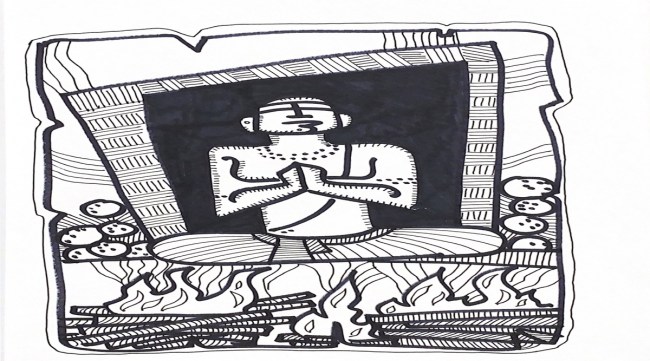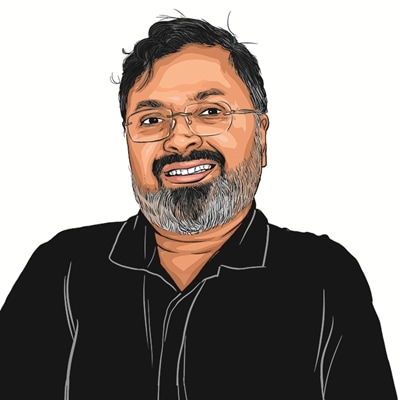Opinion Devdutt Pattanaik writes: What makes the idea of ‘sanatan dharma’ such a contentious issue
In a country as diverse as India, the conflations and confusions of caste with rebirth become the stuff of political media wars
 Always on the defensive, politicians have enabled Hindus to feel comfortable with their customs and beliefs. But untouchability remains a sticky issue. It cannot be justified.(Photo credits: Devdutt Pattanaik)
Always on the defensive, politicians have enabled Hindus to feel comfortable with their customs and beliefs. But untouchability remains a sticky issue. It cannot be justified.(Photo credits: Devdutt Pattanaik) What is sanatan dharma? Sanatan dharma can mean: One, faith in eternal things; two, faith in soul and rebirth; three, faith in the caste system; four, faith in the doctrine of purity.
The politician picks and chooses his or her meaning to suit his agenda. So, if your voter base does not like Brahmins, and the caste system, you can say sanatan dharma refers to the caste-based privileges that are assumed to be eternal. Krishna in the Bhagavad Gita did refer to the varna-based hierarchy based on personalities (guna) of people and called this eternal.
But if your voter base respects Brahmins and is made of those who feel persecuted by caste-based reservations, you can say sanatan dharma is about all things eternal— time, space, soul and rebirth. You avoid all references to caste and untouchability.
Origin of the term: Vedic scriptures, composed 3,000 years ago, do not use the word “sanatan” or timelessness. We find the word in the Mahabharata, whose text was composed 2,000 years ago. It refers to conversations on soul and rebirth, ideas that became popular with the rise of monastic orders, and ideas such as Upanishad, Buddhism and Jainism, about 2,500 years ago. Manu in his dharma-shastra, also about 2,000 years old, makes belief in the soul and rebirth the foundation of caste-based hierarchy.
For traditionalists, however, the events described in the Mahabharata happened 5,000 years ago in 3,000 BCE. They do not respect any historical evidence to the contrary. So they insist that “sanatan” is an ancient, timeless concept. It must be kept in mind that in Buddhist, Jain and Hindu mythology, their doctrine is eternal, and transmitted from time to time by historical Buddhas, Tirthankaras and Rishis. This is a matter of faith, not fact.
Meaning of the term: For Buddhists, nothing is eternal. All things are ephemeral. This belief (dhamma) is timeless (sanatan). For Jains, violence takes one to the lower realms, and non-violence takes one to the higher realms. The world has no beginning (anadi) and no end (ananta). This is the word of the Tirthankara (Jina–vani), which makes these ideas eternal and timeless.
For Hindus, society is based on caste (varna/jati). Different communities have different rites and practices and all need to be respected. Every human is obliged to perform his role as per the family he belongs to, the gender he acquires at birth, and his lifecycle. He has to repay his obligations to family, clan, ancestors, teachers, and society. This is non-negotiable and eternal. Unless we repay debts, we can never be free (moksha). This eternal belief is sanatan dharma. Here, caste consciousness is paramount. With caste consciousness come the ideas of purity, pollution and untouchability.
Essentially, faiths with belief in rebirth can be classified as sanatan dharma. They are distinguished from religions with the belief that we live only once — that is, Judaism, Christianity and Islam.
19th century politics: In the 19th century, there were many reform movements in India based on concepts of justice and equality. Women’s education was being promoted. Education was being made available to all castes. The old was way crumbling. This was spearheaded by reformists whose organisations were concerned about society (samaj). This included Arya Samaj, Brahmo Samaj, Prarthana Samaj and Satyashodhak Samaj.
These were opposed by traditionalists like Bal Gangadhar Tilak who argued that one must not encourage women’s education and education of members of the “lower” caste as it will destroy tradition, and result in instability. These people were called the sanatanis (followers of the old way) and they coined the word Hindutva (principles of Hinduism) which was based on eternal (sanatan) beliefs.
The samaj-sanatani conflict of the 19th century has manifested as the Left-Right conflict of the 21st century. Today, the sanatan group does not openly advocate against caste and women’s rights. But it does valorise the Brahmin community as the foundation of Hindu society. They propagate the pseudo-history that in ancient India all genders and castes thrived and there was no oppression. All oppression came with the arrival of Muslims and missionaries.
Threat to sanatan dharma: The idea of conversion comes from monotheistic faiths. It was popularised by Christian and Islamic missionaries. It wiped out polytheism across Europe, West Asia, Africa and America. India blocked the monotheistic onslaught. Despite eight centuries of foreign rule, by Muslim warlords from Central Asia and later Europeans, less than 20 per cent of Indians converted to Islam and Christianity.
But secular policies of justice and equality threaten the old caste model, which is deemed as oppressive and exploitative. The Indian Constitution strips Brahmins of their social status. It makes the old aristocrats equal to communities who were forced to live on the fringes of villages, forced to do manual scavenging and sanitation work. This is naturally resented, especially when Muslim and Christian religious practices, despite being misogynistic and homophobic, are rationalised rather than criticised. This provides political opportunity to politicians.
Hindus have long felt misunderstood. Around the world, Hindus are mocked because they worship idols and cows. It is difficult to explain caste and rebirth to people. While scientists attack religions, Hinduism finds itself isolated as it is very different from the dominant monotheistic religions of the West. Always on the defensive, politicians have enabled Hindus to feel comfortable with their customs and beliefs.
But untouchability remains a sticky issue. It cannot be justified. It is conflated with caste. Caste is conflated with rebirth and rebirth is conflated with belief in soul and timeless truths. And these conflations and confusions become the stuff of political media wars.
Pattanaik is a writer and mythologist with over 50 books



